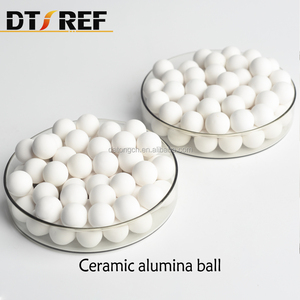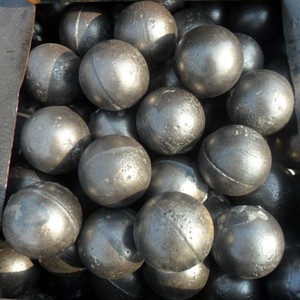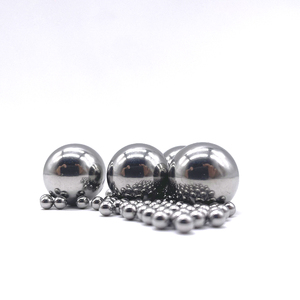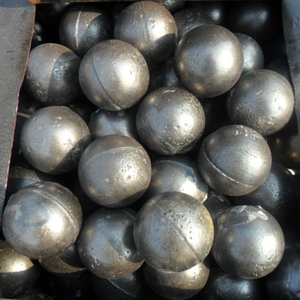
All categories
Featured selections
Trade Assurance
Buyer Central
Help Center
Get the app
Become a supplier

(6323 products available)



















































Grinding iron balls are widely chosen due to their strength; thus, they suit hard tasks. They come in diverse types, making it easy to settle on one that fits the desired application.
Cast iron balls are solid, yet they remain very hard. They are made by pouring molten iron into a ball-shaped mold. The resulting balls are very tough but can become brittle over time. Therefore, they work best in less stressful milling environments.
They have high resistance to wear because of their strong chemical composition. High chrome balls are made from steel that contains high amounts of chromium. It gives the balls excellent durability and extends their life in heavy-duty tasks.
Forged balls are solid and evenly structured. They are made by heating steel and hammering it into the shape of a ball. This process results in strong, tough balls that resist breaking. They are ideal for heavy grinding tasks in mining and cement industries.
These chrome balls offer decent wear resistance, better than regular steel balls but not as much as high chrome. They contain less chromium than high chrome balls, making them affordable. These balls work well in medium-duty grinding applications. They suit industries that need a balance between cost and performance, such as in small mining operations and mineral processing plants.
Grinding iron balls are often used in industry because they are strong and long-lasting. They help make materials smaller by crashing them. Here are some places they are commonly used.
Grinding balls are used to crush ores into powder in mineral ball mills. This process helps workers extract metals like gold, copper, and iron from the rocks. Strong balls provide effective grinding, boosting mining efficiency.
In cement plants, grinding balls break limestone and other materials in ball mills. The balls turn large chunks into a fine powder needed to make cement concrete. Wearing resistant balls increases production rates and cement quality.
Grinding balls assist in the mechanical process of grinding scrap metal or alloys. This work helps refine metals used in making new parts or tools. Their durability allows balls to work harder without damaging.
Paint and coating manufacturers use grinding balls to mix and refine materials. The balls help create smooth, even textures needed for quality paints and finishes. In this application, the balls' non-corrosive nature keeps materials clean and functional.
In the production of tiles and pottery, grinding balls break raw clays and minerals in ball mills. This grinding prepares materials for shaping and firing in ceramics kilns. Long-lasting balls ensure consistent results in large-scale ceramic production.
Chemical plants depend on grinding balls to break raw materials in various chemical reaction production processes. Iron balls help convert materials into important substances like plastics and fertilizers. Their resistance to wear and corrosion keeps the balls effective in challenging chemical environments.
Material Composition
Grinding iron balls are mainly forged from carbon steel and chrome alloy steel because of their high strength and resistance to wear. Some low-end options are cast from heat-treated chrome iron. These materials are chosen due to their capability to handle heavy impacts while resisting abrasion from grinding charges.
Diameter Range
These balls come in sizes ranging from 20 millimeters to 150 millimeters. Smaller balls, 20 to 30 millimeters, work on fine grinding in laboratory ball mills. In contrast, larger balls, 100 to 150 millimeters, suit the coarse grinding demands of industrial ball mills in mineral and cement industries.
Hardness Levels
These grinding media seek hardness of between 55 and 67 on the Rockwell C scale. Optimal hardness ensures the balls maintain a sharp grinding surface without chipping or cracking. This property is critical for efficient material breakdown in mining and cement milling operations.
Heat Treatment
Usually, these balls undergo quenching and tempering heat treatments. The procedure increases their toughness and wear resistance. Heat treatment also improves the balls' microstructure, making them more uniform and strengthening further. This process is essential to ball performance in heavy grinding tasks.
Preparing the Ball Mill
Prior to installation, one is advised to clean the ball mill completely. Remove any old balls, debris, and build-up. One should inspect the mill components for damage. Ensure the liner inside the mill is intact and properly secured. This step prepares the mill for optimal grinding performance.
Loading the Balls
Load the steel ball mill balls into the mill carefully. For even distribution, one is advised to add them gradually. In heavy-duty applications, larger balls should be placed first, then smaller ones on top. This process ensures balanced grinding during operations.
Filling with Material
After adding the balls, fill the mill with the material that needs grinding. Control the fill level to be around 50 to 70 percent of the mill's capacity. This amount allows sufficient movement of the balls, enabling efficient grinding processes.
Starting the Mill
After the balls and material are added, one is advised to close the mill securely. Then, follow the operating instructions for starting the mill. One should begin with a low speed to allow the balls to settle into the material properly.
Regular Inspections
Often, one should check the grinding balls for signs of wear, cracks, or surface damage. Also, the ball mill lining should be inspected for wear or deterioration. Catching issues early helps avoid larger breakdowns.
Monitoring Ball Size
As grinding progresses, the balls will wear down and get smaller. One should measure the balls' diameter regularly. If they shrink too much, replace worn balls with new ones. Using the correct ball size ensures efficient grinding continues.
Proper Ball Replacement
Replace balls that have significant wear or damage. One should follow safety guidelines for replacing balls. Normally, switching worn balls out promptly prevents uneven grinding and power overloading, which, in return, affects the efficiency of the operations.
Lining Maintenance
A regular coating check and replacement is needed for the ball mill lining. Worn lining can damage the balls and reduce grinding effectiveness. They, therefore, should be replaced according to the manufacturer's recommendations. This maintenance helps maintain proper ball movement and protects the mill from damage.
Lubrication
Regularly lubricate the ball mill components as per the manufacturer's specifications. Proper lubrication reduces friction and wear on the parts. It also prevents overheating, leading to ball failure. Focus on the bearings, shafts, and gear system.
Quality directly impacts grinding efficiency and equipment longevity. High-quality balls produce finer material quicker.
Grinding balls are mostly made from carbon alloy steel and chrome alloy steel. They feature high resistance to wear, delivering great performance. Quality chrome steel balls exhibit high toughness, keeping balls intact amid grinding forces. They also have high hardness, providing sharp edges for extended wear. Often, these properties result in reduced replacement costs and increased up-time during operations. This happens because a rocker lasts longer without breaking down.
When making grinding balls, leading manufacturers follow ISO and ASTM metal family. These standards guarantee consistency in hardness, size, and weight. It ensures that all balls perform equally well. Uniformity leads to balanced grinding in mills, producing homogeneous outcomes. This consistency avoids situations where some balls break down quickly, while others perform adequately.
Prior to delivery, products are often subjected to rigorous tests. These tests evaluate hardness, diameter, and surface finish. Hardness tests ensure the material isn't too soft or brittle. A surface finish test eliminates flaws that may cause weak points. Such imperfections lead to uneven wear during operations. Also, testing helps identify defective items early, preventing them from entering the market.
Personal Protective Equipment
Workers handling steel media for concrete should always wear appropriate PPE. Things like gloves, safety glasses, and helmets are important. These items protect against potential hazards like flying debris or heavyweights. This debris could injure a worker's eye, while heavy weights may cause severe injury to the feet.
Proper Handling
Iron balls are extremely heavy and can cause serious harm if dropped. Workers should use dollies or hoists to lift heavy objects rather than attempting to lift them personally. This fact prevents back injuries and other strains.
Emergency Procedures
One should always be advised to always have first aid kits and medical support. They should also be familiar with emergency response plans. If an accident occurs, aid gets to the patient quickly, minimizing further risks to health. Emergency procedures include mandatory practices for basic injuries and when to transport someone who is injured.
Avoiding Exposure
Workers are advised against inhaling dust created during the handling of grinding balls. Always ensure proper ventilation. Use exhaust fans and air purifiers to improve airflow and minimize dust accumulation. It reduces respiratory risks associated with fine metal particles.
Forged balls have a more even and dense structure, making them stronger and more resilient to wear. Cast balls, while tougher, can be more brittle. This property causes them to crack under heavy stress. Forged balls are better for high-impact grinding applications. These applications include mining and cement industries. At the same time, cast balls are sufficient for lighter milling tasks.
The chrome ball grinding process provides better wear resistance and longer life for the balls. The higher the chrome content, the stronger the balls become against abrasion. Thus, this process is ideal for industries requiring heavy-duty grinding, like mining and cement. In comparison, standard steel balls wear out faster and require frequent replacement, which is costly in the long run.
No, the balls do not have to be of the same size. In fact, using different sizes is advantageous. Smaller balls grind fine materials, while larger ones break down coarser chunks. A mix of sizes goes the extra mile by improving grinding efficiency and producing a better end product. It optimizes the surface area for contact and collision within the milling process.
One should replace them upon noticing a significant decrease in grinding efficiency or an increase in power consumption. Closely monitoring ball wear can do this. Frequent inspections reveal worn surfaces, visible cracks, or changes in ball shape. That being said, the presence of these factors deteriorates the grinding process. It leads to uneven wear and decreased output. So, regular maintenance combined with performance monitoring allows timely ball replacement. It helps avoid costly downtimes or equipment damage.
The lifespan of these balls can vary widely based on factors like mill conditions and the type of materials being ground. Normally, they can last from several months up to a few years. In high-impact environments, tougher wearing balls, such as forged steel ones, can last longer. Normally, they require frequent monitoring to ensure optimal performance. That is what prevents premature ball failure from occurring.